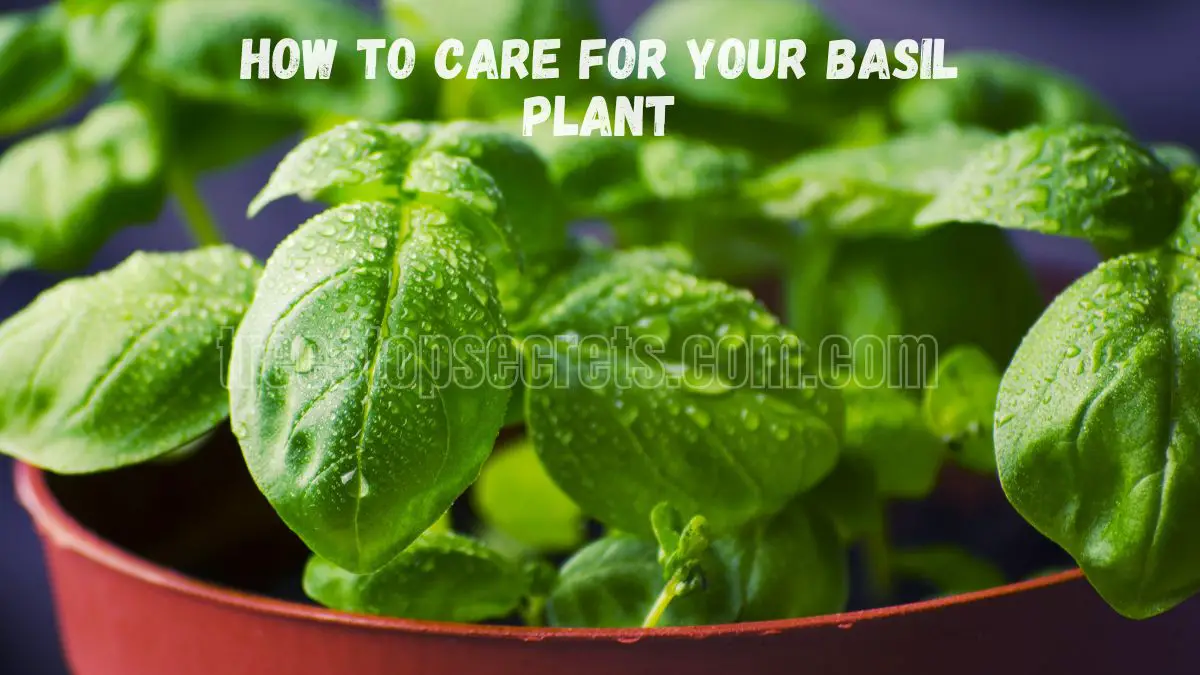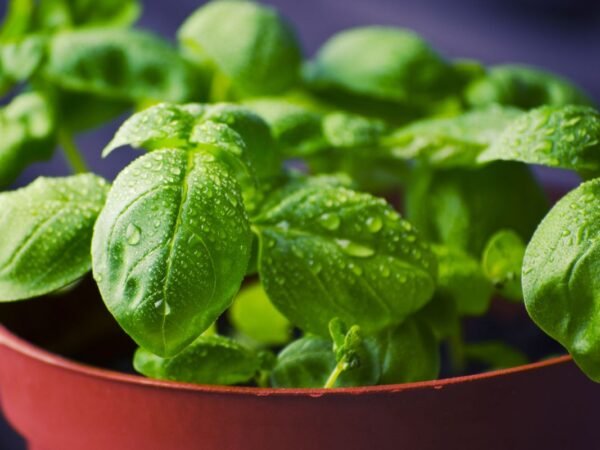Key Takeaways
- Select the basil type that will suit your cooking, such as sweet or Thai basil. Plus, consider your home climate as well to ensure you grow herbs successfully.
- To get them off to a good start, start seeds indoors 6-8 weeks before your last frost date. Use biodegradable pots for successful, stress-free transplanting outdoors.
- Keep the soil acidity between 6.0 and 7.0. Choose a fast-draining potting mix and amend with organic matter to boost water and nutrient retention.
- Set up a regular watering routine of 1-2 days. Practice deep watering methods to help promote strong root growth.
- To keep your basil plants from flowering and encourage bushiness, prune them frequently. In order to get a long healthy harvest from your plants, only harvest one third of the leaves at a time.
- Basil prosper best when grown with tomatoes or peppers. This beneficial companion planting tactic accelerates growth, deters unwanted pests, and enhances the healthiness of your garden.
Caring for a basil plant means getting it enough light, water, and food to produce its best fragrant leaves. Basil does best in bright direct sun.
Put basil near a sunny window or outside in a garden to encourage the plant’s growth. This way, when you water it, you can feel the top inch of soil and avoid overwatering it while making sure that your plant has enough moisture.
Frequent harvesting of the leaves will not only result in a bushier plant, but it will improve the flavor. Knowing the ins and outs of what your basil plant needs will ensure that you have plenty to use in your kitchen or as a garnish.
In the rest of the basil plant care guide, I’ll be sharing pro tips and tricks to get you growing basil like a pro in no time.
Starting Basil Plants
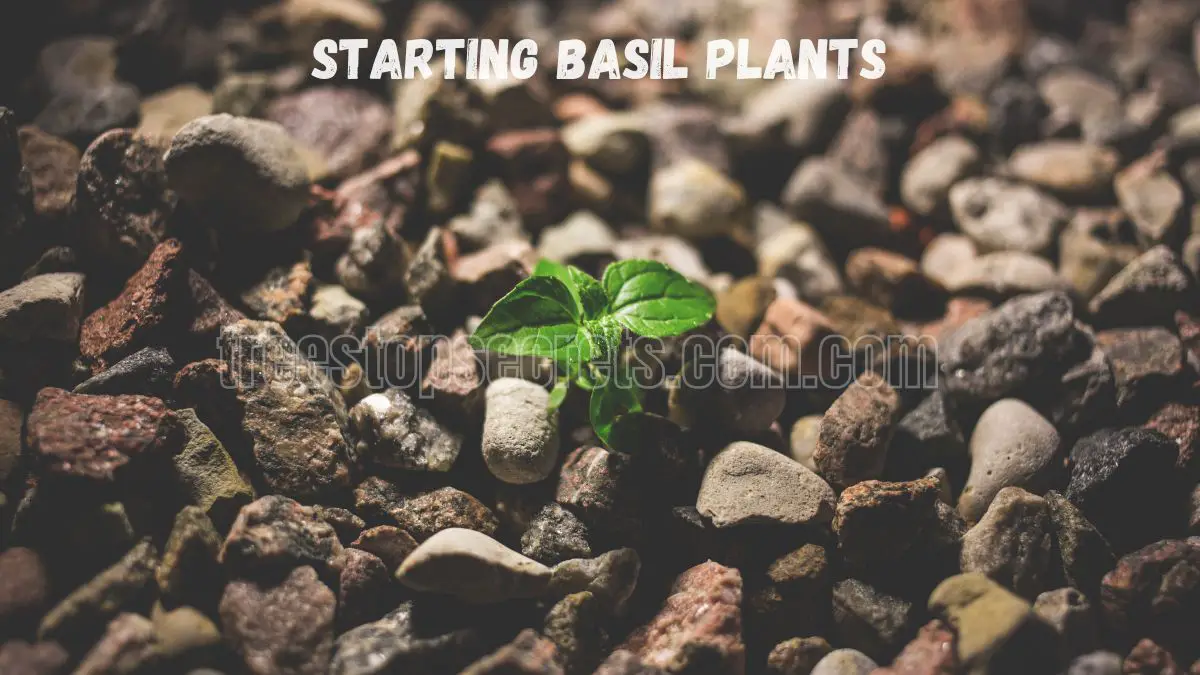
If basil plants are grown properly, they will do well. Choosing the right variety is the first step. You may prefer Genovese for Italian cooking or Thai basil for that aromatic, spicy depth of flavor.
Getting to know the flavor profiles of sweet, lemon and holy basils will take your culinary skills to the next level. It’s smart to know ahead of time what varieties grow best in your specific region, guaranteeing that you’ll have a robust crop. Don’t be afraid to try your hand at growing a combination of these different basil varieties! It’s sure to provide a wonderful new dimension to your kitchen creations.
Sowing seeds inside provides you greater flexibility and control over germination. Start indoors 6 to 8 weeks before your last expected frost. You’ll be amazed to see seeds start sprouting in 5 to 7 days!
Once seedlings have grown true leaves, they’re ready to transplant outdoors. Choose compostable pots. Biodegradable pots make it less stressful to transplant seedlings, with little disturbance of the roots, for a smoother move-in process for your new babies.
Soil composition is just as important. Healthy roots are ensured with a well-draining mixture of compost, peat moss, and perlite. Make sure to keep the soil pH tested regularly, and keep between 6.0 and 7.0, which is perfect for basil.
Adding organic matter to your soil increases nutrient availability, leading to healthier and more robust growth. Timing is crucial when it comes to planting basil seeds. Hold off until at least your last frost date, ideally 2 weeks after that, and make sure the soil is warm—at least over 70°F.
With this thoughtful planning you’ll have strong plants, ready for harvest as soon as they’re established outside.
Essential Care for Basil
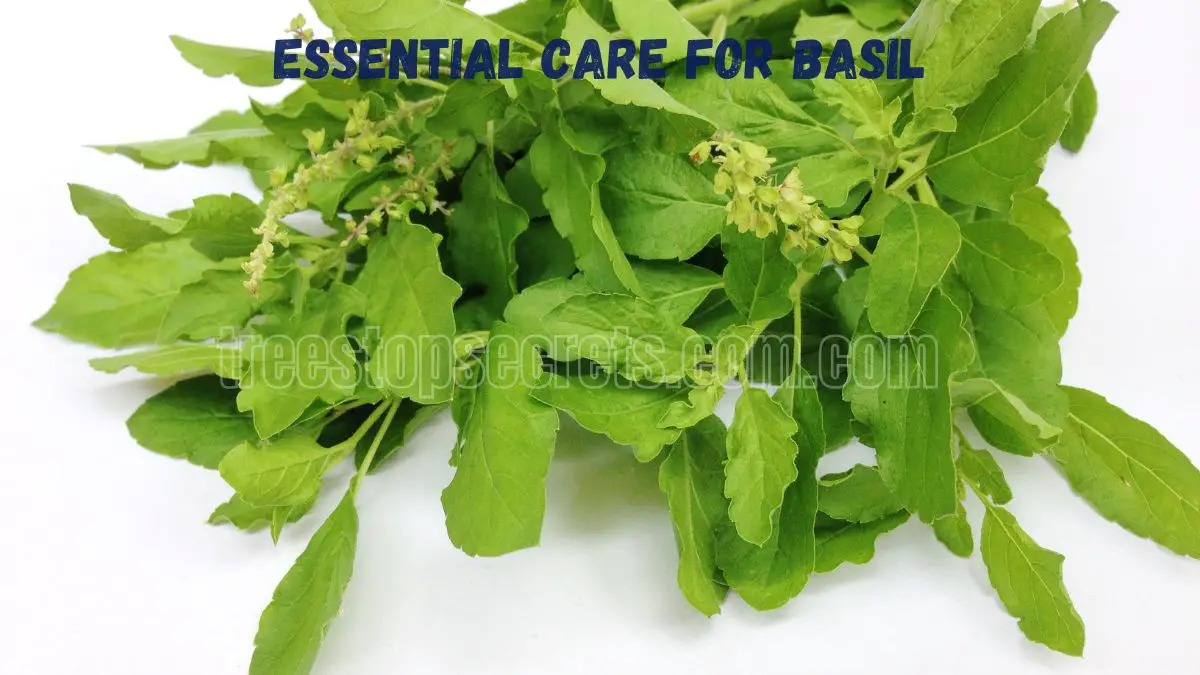
There are a few essential practices of caring for basil that will keep your plants healthy, happy, producing lots of big leaves. Figuring out how often your basil should be watered is essential. Water basil every 1-2 days, or more often in hot, dry weather.
A slow, deep watering encourages healthy root establishment. By allowing the top 1 to 2 inches of soil to dry out before watering, you are preventing overwatering. To prevent fungal diseases like damping off, water right at the soil surface.
Fertilization is critical to fostering strong vigorous growth. Feed your basil with an organic fertilizer such as fish emulsion or compost tea once a month to keep it thriving. Using slow-release fertilizers at the beginning of the growing season will help ensure an even nutrient release throughout the desired growth cycle.
Once crops have been heavily harvested, fertilize once more to promote rejuvenating growth. Fertilize basil moderately, as heavy fertilizing can produce a lot of leaves but less flavorful ones.
Proper light is absolutely necessary for success with basil. Position your plants so that they’re getting full sun for a minimum of six hours a day. Rotating pots for even light exposure helps, and if you’re growing basil indoors, use grow lights when days grow shorter.
Monitoring leaf color can indicate light levels. Dark green leaves suggest sufficient light, while pale leaves may hint at a deficiency.
Finally, keeping the right temperature and humidity is key. During its growing season, basil likes temperatures on the warm side — between 70°F and 85°F. To maintain humidity, set trays filled with water around plants or periodically mist them.
Plants, just like people, can get sick if you don’t protect them from cold drafts and temperature extremes.
Pruning and Propagation Techniques of Basil
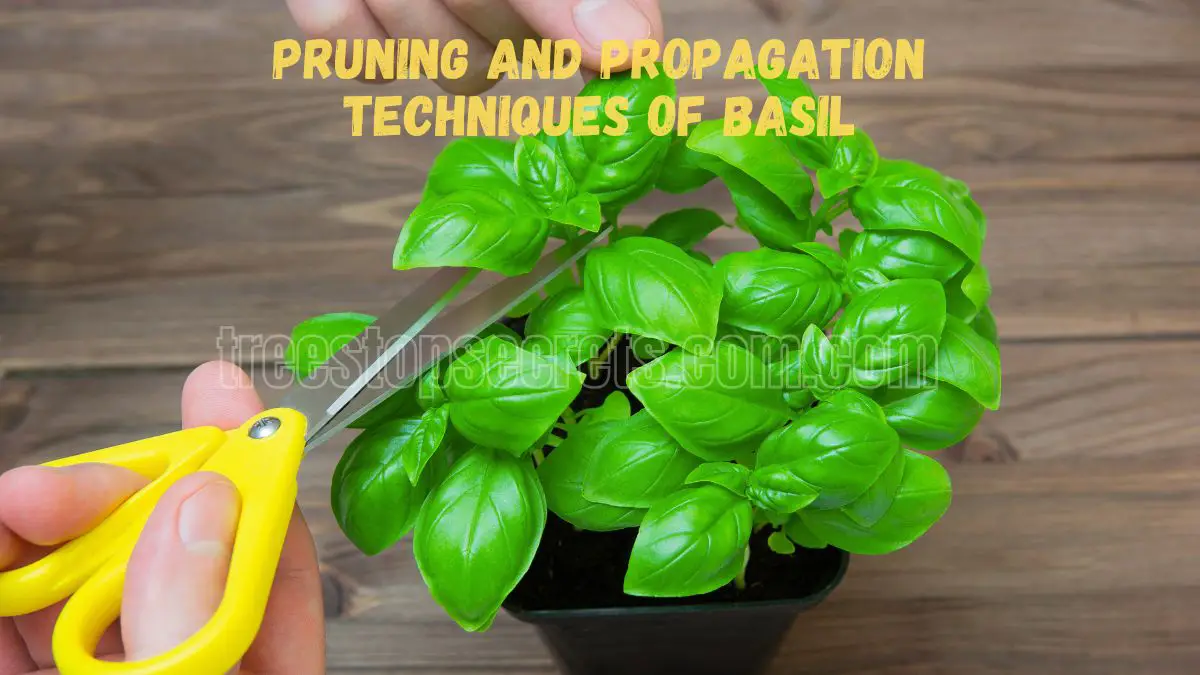
Caring for your basil plant means learning how to properly prune and propagate it for healthy growth and optimum plant vitality. Pinching back here and there during the season will encourage bushy, compact growth and minimize flowering.
Cut back your basil every two weeks throughout the warmer months. For the best results, cut 1/4 inch above a set of leaves. This causes the plant to want to branch out creating more leaves and a bushier plant.
With regular pruning, you’ll promote the growth of your basil into its most fruitful and vigorous state. So for instance, if you cut back a stem to a leaf node, look for two new stems to grow from that location.
1. Effective Pruning Methods to Enhance Growth
To keep everything in proportion and avoid them suffocating each other, prune back vigorous plants by cutting off any yellow or dead leaves. This will not only help your basil stay healthy overall, but it opens up air flow.
Plan prunings at intervals of about two to three weeks during the growing season to ensure healthy, productive plants and a bountiful harvest.
2. Advanced Techniques to Prevent Bolting
Watch your basil plants closely, and if you see flower stalks starting to appear, remove them immediately. Bolting is a stress response, so keeping your growing plants well-watered and nourished will help prevent this.
Creating the shade so important during extreme heat allows for a longer growing season. Frequent leaf harvest will stimulate new leaf production and help to postpone the flowering process.
3. Propagation Methods for Strong Basil Plants
For propagation, simply cut 4-6 inch cuttings from healthy basil branches. Keep the cuttings in water until roots start to grow, and then nurse them into soil.
When propagating in soil, using a sterile medium helps to avoid disease. Properly labeling your propagated plants will help you to keep track of the various basil varieties.
Harvesting and Storing Basil
Frequent pruning of the leaves stimulates new growth and will give you a continual harvest of fresh basil. When the time comes to harvest, snip off stems just above a set of leaves. By using this technique, you’ll encourage bushier growth and keep your basil plant growing strong.
Just be careful not to take off more than a third of the plant in one go. This practice keeps the basil from becoming stressed and encourages new growth.
1. Best Practices for Harvesting Basil Leaves
Using clean scissors or shears is crucial to avoid damaging the plant during the harvest. The ideal time to harvest is early in the day when the leaves are their most savory and aromatic.
Concentrate on harvesting large leaves from the top down, because these produce the highest quality. It can be useful to leave the smaller leaves at the base when you harvest so that the plant can keep growing.
2. Post-Harvest Handling for Maximum Flavor
After you’ve harvested, rinse the basil leaves in cool water to remove any dirt and debris. Pat them dry with a paper towel to remove excess moisture, which causes them to spoil quickly.
Be careful not to crush the leaves, which will ruin the essential oil and flavor. Using your harvested basil right away ensures the best flavor.
3. Storing Fresh Basil for Longevity
For short-term use, keep basil like you would a bouquet — in a vase of water on the counter. Wrap the base of the vase with a plastic grocery bag to help keep the basil humid and perky.
To store basil long term, basil leaves can be frozen in freezer bags. You can hang basil leaves to dry in a cool, dark place to store for seasoning.
Managing Pests and Diseases
Proper basil care requires vigilance for pests and diseases. By regularly examining your plants, you’re more likely to notice when something goes wrong. Frequent pests such as aphids and whiteflies are attracted to basil’s tender foliage.
If you find these pests in your garden, you can treat them easily with organic insecticidal soap that doesn’t harm beneficial insects. In cases of heavy infestation, picking off and destroying infected leaves will reduce the chances of pests spreading. Keeping a tidy garden space reduces possible habitats for these intruders too.
1. Common Pests Affecting Basil and Their Control
Aphids, spider mites, and slugs are some of the most hated pests that love to eat basil. As a natural pesticide, neem oil works wonders to defend your plants from harm and keep your beneficial insects safe.
Introducing ladybugs into your garden is another great way to control pest populations naturally. Inspect basil closely and often to catch the first signs of infestation so you can take action as quickly as possible.
2. Identifying and Treating Fungal Issues
Fungal diseases including downy mildew and powdery mildew can quickly destroy an entire basil crop. Typically, yellowing leaves and white spots are among the first symptoms of infestation.
Improving air flow around your plants reduces humidity and fungal infections. It’s critical to remove infected leaves as soon as possible to avoid spreading the disease. When indications warrant, use organic fungicides to cut down widespread infections.
3. Organic Pest Management Strategies
Companion planting is an environmentally-friendly method to prevent pests. Try using barriers such as floating row covers to protect your basil.
Annual crop rotation interrupts pest reproductive cycles, minimizing the likelihood of infestation and maximizing the health and vigor of your plants. Homemade sprays with garlic or chili pepper can work really well.
Troubleshooting Common Basil Issues
Basil plants, particularly ocimum basilicum, can be susceptible to several problems, but catching these issues early will ensure a healthy, vigorous plant. Here’s a look at common basil problems and how to avoid them for a successful leafy harvest.
1. Recognizing Nutrient Deficiencies Early
Usually yellowing leaves indicate a nitrogen deficiency. If you find that your basil’s leaves are developing purple colors, it is possible that phosphorus is deficient.
If you notice leaf drop or curling, it could be a sign of potassium deficiency. With the ability to see these changes, you can change your fertilization practices right away, feeding your basil the vital nutrients that it needs.
2. Addressing Yellowing Leaves and Other Symptoms
When diagnosing yellowing leaves, be sure to look at both soil moisture conditions and nutrient levels. Be sure to change your watering schedule so that you’re neither overwatering the plant nor underwatering it, both of which can stress the plant.
Applying a balanced organic fertilizer will quickly replenish nutrient levels. Cutting down the damaged leaves allows new healthy growth to emerge and stops any problem from spreading.
3. Solutions for Poor Growth and Flavor
Evaluate your basil's light exposure. If the plants appear leggy or weak, adjusting their placement for optimal sunlight access is crucial.
Consistent watering and a reliable nutrient supply are key to boosting growth. Regular pruning encourages bushier plants and enhances flavor.
You might consider experimenting with different basil varieties to discover which ones deliver the best flavor profiles for your culinary needs.
Companion Planting with Basil
Using basil in companion planting will go a long way in boosting your garden’s health. With the right companions, basil can help create protective and nurturing environments that stimulate vigorous growth and enhance flavor profiles. For example, planting basil next to tomatoes produces a flavor synergy that adds to the enjoyment of both crops.
The aromatic oils found in basil can help kill common deadly pests for tomatoes, making this an ideal symbiotic pairing.
1. Benefits of Companion Planting for Basil
Companion planting can maximize pollination by inviting beneficial insects to basil’s sweetly-scented flowers. These beneficial insects, including bees, fertilize nearby plants, resulting in higher yields. Basil’s potent aroma acts as a decoy, throwing off common nuisances such as aphids and spider mites that would otherwise jeopardize your other crops.
This natural pest control leads to healthier plants and less reliance on chemical interventions. In addition to maximizing space, through planting a variety of crops, crop rotation improves soil health, nutrient richness, and creates a thriving environment for growing.
Prevention A diverse garden environment builds strength in numbers, helping all plants grow in harmony.
2. Ideal Plant Pairings to Enhance Growth
Pairing basil with tomatoes is a winning combo for flavor and pest prevention. Growing basil with peppers encourages their growth while making a colorful vegetable garden. Interestingly, basil can be a great companion to carrots by improving their flavor and giving them some ground cover to help suppress weeds.
Experimenting with various pairings will help you find the most effective combinations suited to your garden’s specific environment.
Advanced Growing Techniques
To get the most out of your basil plants, adopting more technical methods can help you achieve higher growth, flavor, and better yield potential. These techniques fine-tune your plants’ growing conditions and inputs, yielding great results.
In the end, your time spent in the garden will be more fruitful and productive.
1. Utilizing Greenhouse Microclimates for Better Yield
Developing controlled microenvironments inside greenhouses has been central to learning how to produce basil at peak condition. Providing proper shading and ventilation will help you keep temperature and humidity at appropriate levels, which is key for producing vigorous, healthy plants.
For example, a greenhouse with good ventilation will avoid excessive heat buildup and maintain sufficient airflow. By keeping an eye on microclimates, you can find and provide optimal conditions for different basil varieties so you can give them exactly what they require.
Running trials on different greenhouse configurations and methods can pay major dividends in improving productivity. Cooling them with additional fans or shade cloth will help produce healthier, more vigorous plants.
2. Impact of Different Watering Methods on Flavor
From ebb-and-flow to flood tables, the method you use to water your basil plants can strongly impact their taste. A side-by-side taste test of drip vs. Traditional watering methods found a huge difference in flavor.
Basil’s aroma and flavor are both improved with consistent moisture, easily accomplished through drip irrigation. Depending on how often you water, for example, could affect the intensity of your plant’s flavor.
Using rainwater, the most natural water source of all, for watering your crops too? It contributes rare minerals that can help develop deep flavors in your fruits and vegetables.
Make a note of your flavor variations to help you determine the best watering methods to produce tasty basil. This means better flavor and a more delicious harvest!
Conclusion
Caring for basil will be one of the most enjoyable and richly rewarding experiences. With just a few easy steps, you can experience the taste of fresh culinary herbs right in your own kitchen! Begin with quality seeds, ensure sufficient light, and maintain a moist environment. Frequent pruning encourages more foliage and stronger flavor. Harvesting your basil will allow you to enjoy its incredible flavor in many delicious recipes, and storing basil the right way preserves its flavor. Keep an eye out for pests, and address problems immediately to keep your plants green and vigorous. With these tricks up your sleeve, pairing basil with the right companions helps your garden grow. Join us to explore deeper methods to enhance your horticultural expertise. Enjoy the journey and feel accomplished with your homegrown basil. Begin your basil growing adventure today and experience the crisp flavor of homegrown basil harvested just steps from your kitchen.
Frequently Asked Questions
How much sunlight do basil plants need?
Basil plants, especially culinary basil varieties, thrive in full sun, requiring at least 6 to 8 hours of direct sunlight daily. This ensures steady growth and the production of sweet, aromatic leaves.
What type of soil is best for basil?
Choose well-draining soil that’s high in organic material. The sweet basil plant grows best in soil with a pH level between 6.0 and 7.0.
How often should I water my basil?
Water basil, a fragrant herb, when the first inch of soil is dry to the touch, ensuring the soil is evenly moist to prevent root rot.
When is the best time to harvest basil?
Harvest individual leaves of basil, such as genovese basil or lemon basil, as soon as the plant reaches at least 6 inches in height. Frequent harvesting prevents flowering and promotes bushier growth for flavorful leaves.
What pests commonly affect basil plants?
Common pests like aphids, spider mites, and whiteflies can affect indoor basil plants. Check leaves frequently and apply insecticidal soap if you see an infestation.
How do I propagate basil?
One of the easiest ways to propagate basil, particularly culinary basil, is by using stem cuttings. To propagate, snip a healthy stem, place it in water, and allow roots to develop before transplanting.
Can I grow basil indoors?
The short answer is yes – you can grow indoor basil plants. Ensure they receive enough light, preferably from a south-facing window, or supplement with grow lights to thrive.
Image Source: Paid image from CANVA

